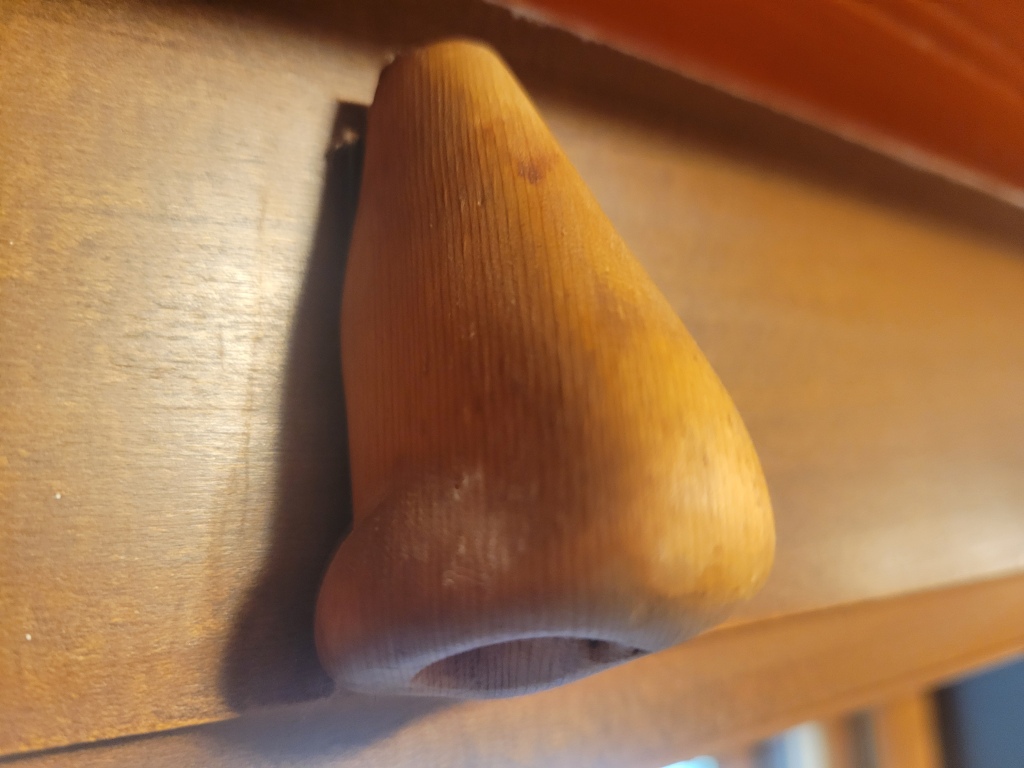
My dentist’s office plays nonstop HGTV in the waiting room and treatment rooms. You may have access to this channel or be familiar with the type of show that I only see on (too-frequent!) dental occasions. From my limited exposure there always seem be two presenters, both with blazingly over-whitened teeth and amphetamine-like energy levels, who host home makeovers in shows that should all be titled What Throwing Money At A House Can Do.
These hosts wield a crowbar or carry materials, narrating as they pretend to work, while the real crew behind them gets the job done. Even though I’ve only seen samples of such shows, I’m already weary of the word pop as used in “pop of color” when they wallpaper the ceiling or “now that wall really pops” when they cover gorgeous old bricks with paint.
What confuses me more comes near the close of each show, when before photos are contrasted with after photos. It seems strange how much more attention is given to frippery than structural or functional changes. I particularly wonder about the designer’s insistence on filling the home with new furniture, new art on the walls, new dishes on the table, new baubles on the shelves. Sometimes there’s a bespoke touch, like a whimsical picture of the family dog framed over the sofa or a giant letters hanging on the wall with whatever word the homeowners said was their personal motto.
Meanwhile I’m wondering happened to the rocking chair and family photos from the before pictures. Who played the piano the designer decided didn’t fit the repurposed space? Where are all the toys from messy bedrooms of actual kids? Where are the books now that the old shelves have been ripped out? Where’s the antique umbrella stand that held ostrich feathers from a family vacation? During the big reveal, the home’s occupants almost always shriek something like “I can’t believe this is the same place” or “I don’t recognize a thing.” Is that a positive?
It’s not like we become better versions of ourselves when we wear the newest fashions or drive the flashiest car or use the latest tech. Of course that’s what our consumer culture has been telling us from the time we were toddlers—spending creates happiness! Yet, more materialistic people, from childhood on, are not happier. According to research cited in The High Price of Materialism by Tim Kasser, people who hold materialistic values are more likely to suffer from a whole dumpster load of problems. This includes aggressive behavior, insecurity, depression, low self-esteem, narcissism, even physical maladies. And when people place high value on material goals, they’re prone to have trouble with interpersonal relationships and intimacy. Materialism is also related to less independent thinking and lower value placed on being “true to oneself.”
In fact, people living in small-scale societies considered, by industrial world standards, to be living in subsistence poverty are among the happiest in the world, expressing greater life satisfaction than Finns or Danes who media reports tell us are the happiest people in the world.
I look around at my resoundingly not-fashionable home and yes, I’d like to replace the peeling linoleum and the falling-apart kitchen cupboards. I’d like to finally get the molding nailed in place instead of stacked in the basement. But I can’t imagine tossing out the memories embedded in the furniture, the art, the books, the dishes, even the Pyrex measuring cup so old its markings are no longer visible.
The things that mean something to us are uniquely embedded in our memories.
These shelves my sister designed and made have long been used to hold a gloriously messy assortment of kid books.
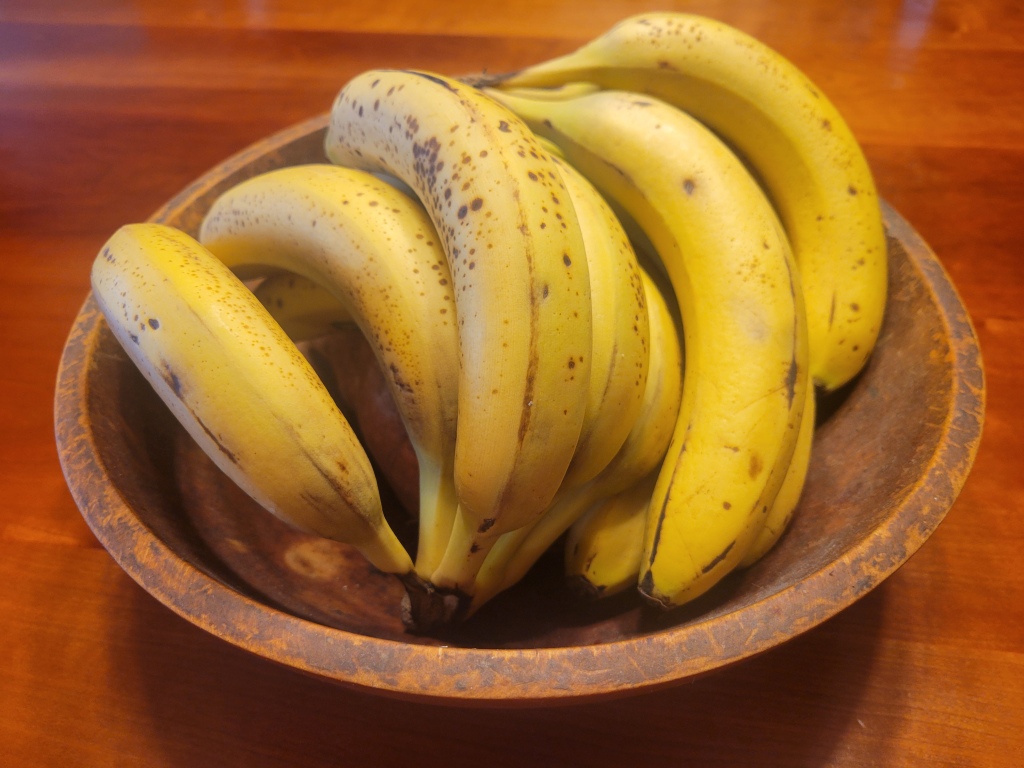
This ancient wooden bowl came to us from generations back. It has always held fruit on the counter.
This is the tiny rocking chair my dad and his sibs rocked on, played with, and teethed on. It was used by countless cousins till it came to us.
This admittedly worn but sturdy chair belonged to my Great-Aunt Mildred, which means it’s at least 70 or 80 years old. It probably needs to be recovered, but I don’t mind it as it is. Paired with a floor lamp from my parent’s home and footstool with crewel work by my grandmother and this corner of my bedroom is perfect for reading into the middle of the night when insomnia has me in its grip.
My husband made this substantial bathroom vanity from an old chest of drawers.
And art, oh art, every piece of art we have has a story. I’ll share only a few pics.
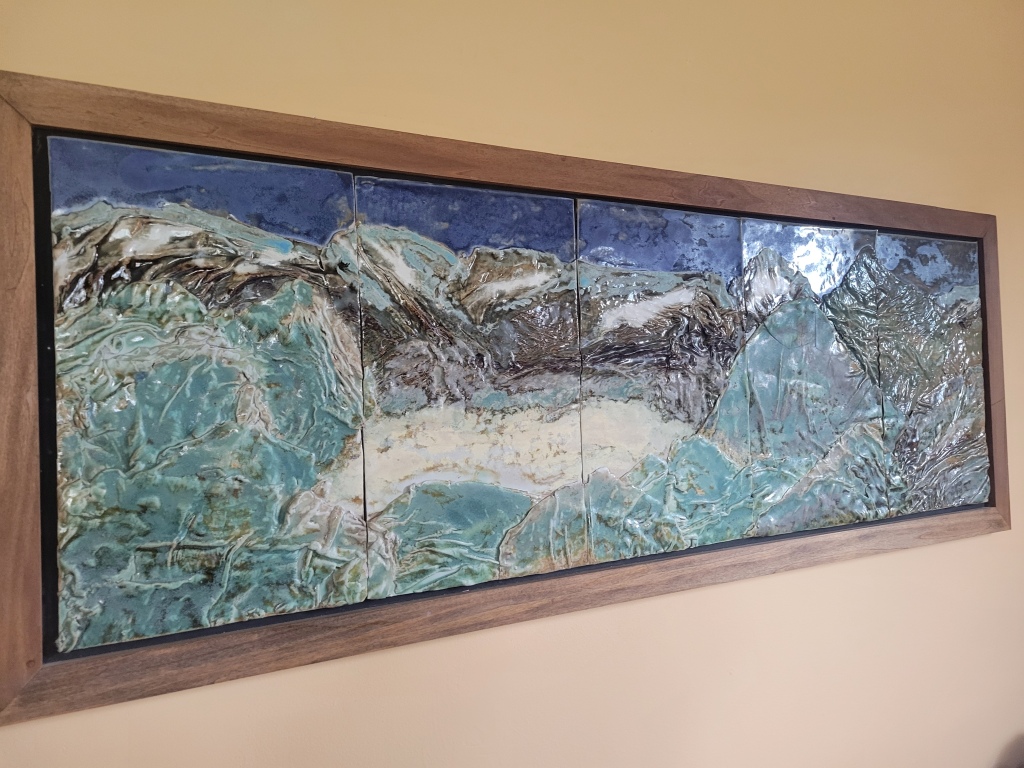
This gorgeous piece is by our friend, ceramics artist Stephen Bures. Years ago we put in our first and only claim on our homeowner’s insurance after our roof sustained storm damage. We bought this piece with the settlement and fixed the roof ourselves. #priorities
This unsigned work was made by a resident of the Medina County Home. He carved the figures from lumber cut-offs, used cotton left over from medication bottles for the hair, and painted it with materials from the home’s activities department. It’s a depiction of a music group his brother formed during the Great Depression. The drum reads TED MACHLES ALL-GIRL ORCHESTRA. He was tickled that we considered it art.

This sweet little wombat was made by my daughter when she was around 11 years old.
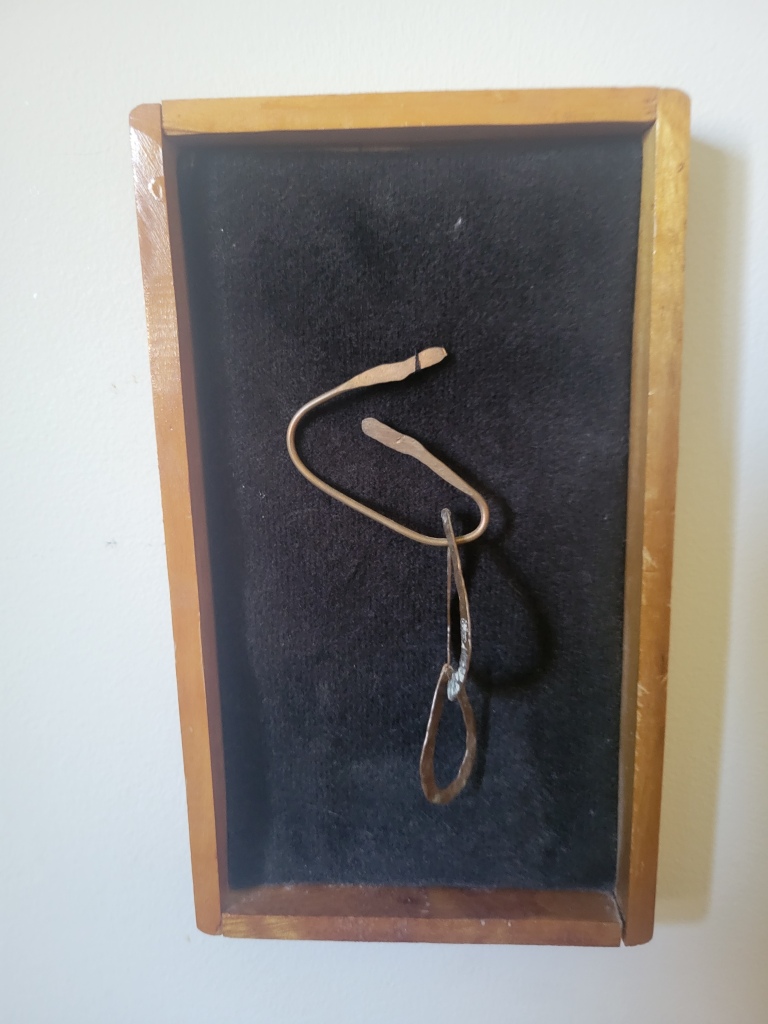
And this sculptural piece was made by my middle son when he was 8 or 9 by hammering and mounting copper wire. (I have a much more elaborate copper mobile he made hanging from the ceiling but I’m not photographing it due to its heavy decor of dust.)
There’s too much to show you, but I’ll close by telling you about the spectacular nose at the start of this piece. It was carved by my brother when he was 13 or 14. It has always hung in my kitchen and is one of the things I’d save if there was a house fire.
In a world of crass materialism, appreciating what we have isn’t just about frugality or simplicity. It’s about quiet satisfaction found in meaning and memory. Things made with “wakened hands,” as D.H. Lawrence wrote, “are awake with transferred touch, and go on glowing for long years.”
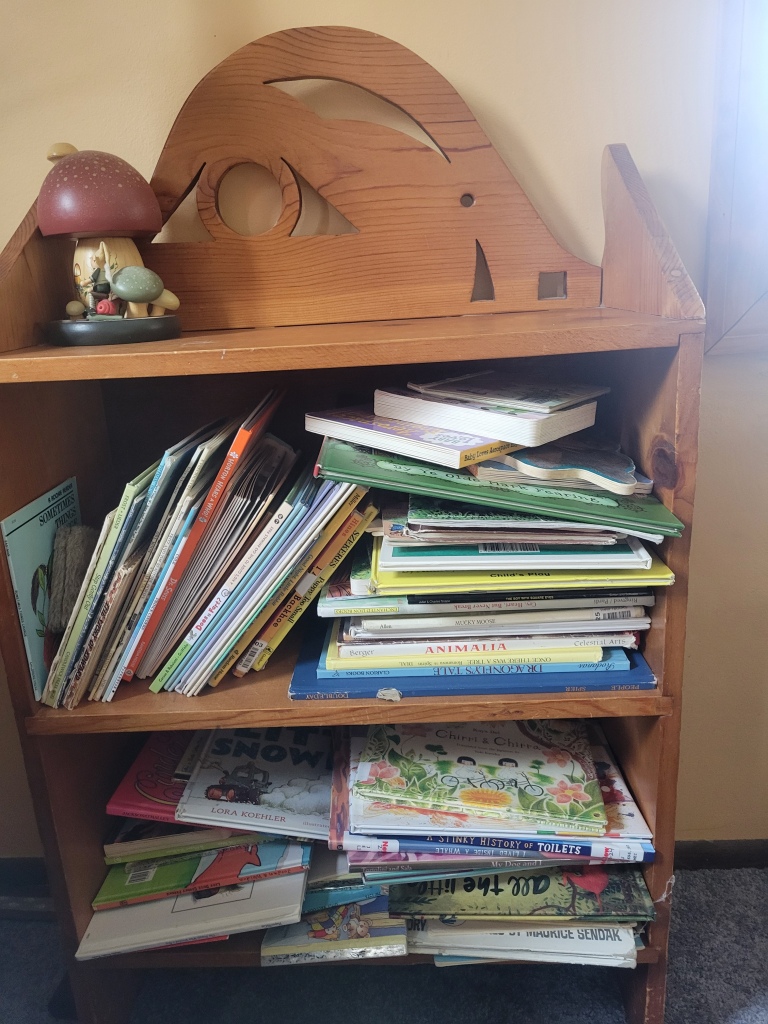
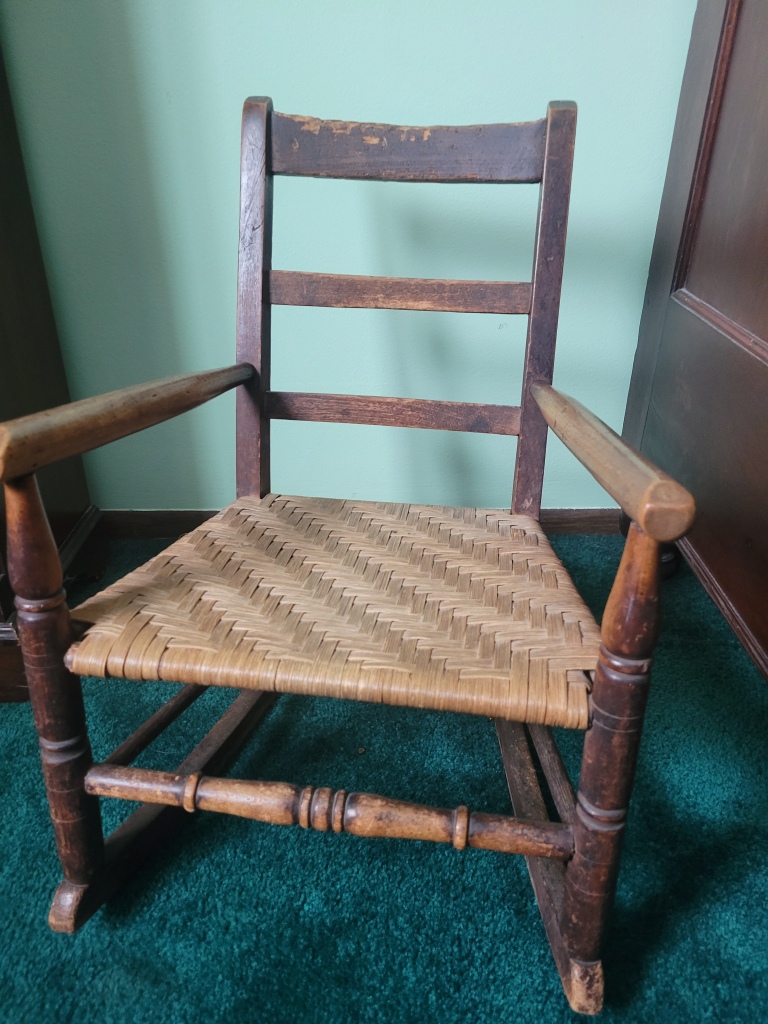
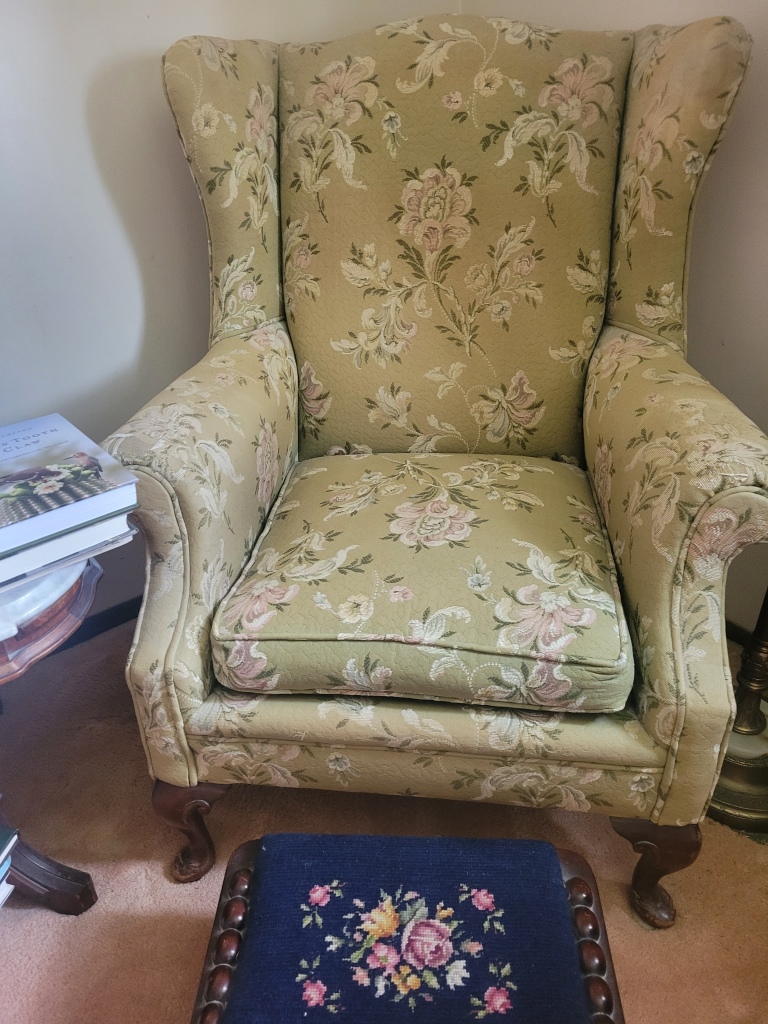
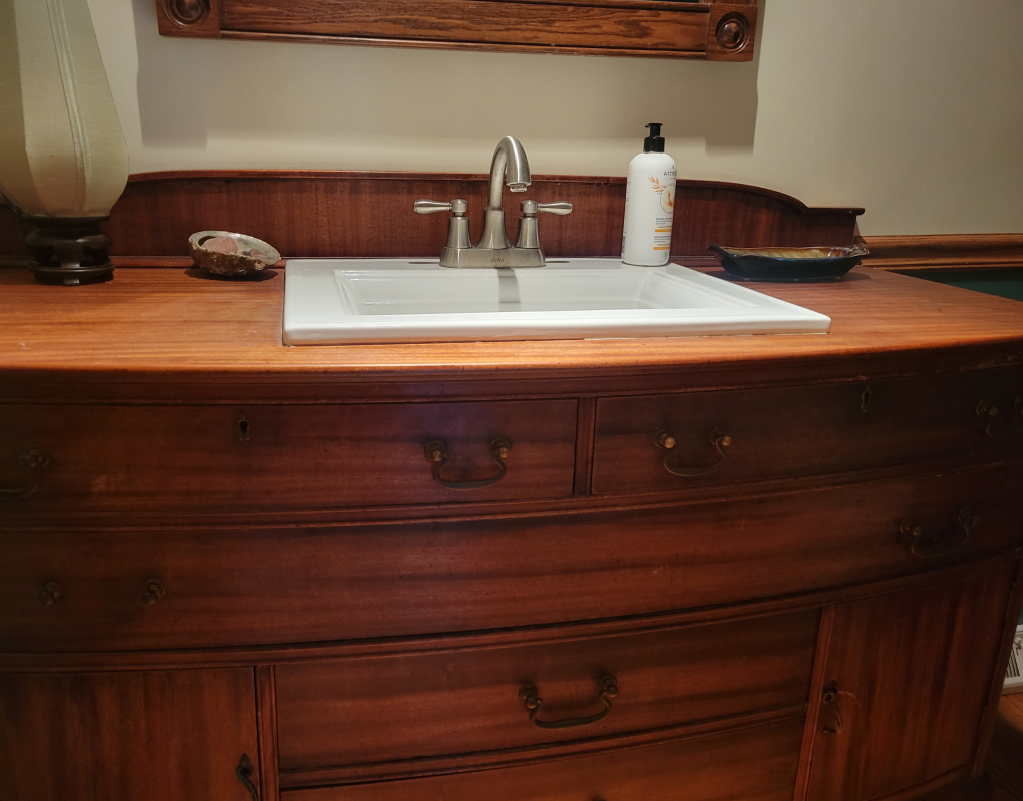
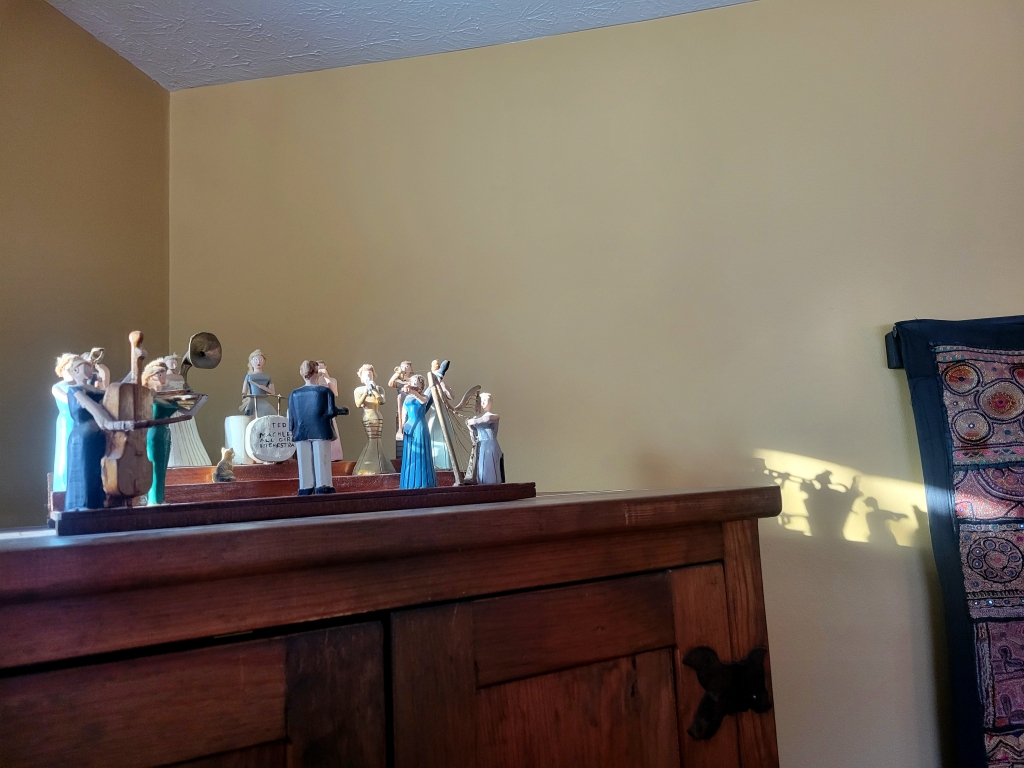
My fixup/addiction has been old houses. This one I wouldn’t trade for any other of my accomplishments. And I wonder if my walls need a new coat of paint. New color? Maybe. Thanks for the walk down memory lane.
LikeLiked by 1 person
Your home is such a gracious, art-filled, welcoming place — it’s a beautiful reflection of who you are.
LikeLike
Laura, I LOVE this essay. Thanksomuch!
LikeLiked by 1 person
Thank you Michael!
LikeLike
Oh Laura, how I love this post! While I have a sister who only wants the Joanne Gaines look in her house, mine is filled with things with so much meaning to me. Every day I can look somewhere and remember the time I spent with grandkids making things, the places I have been and picked up rocks. Not to mention the jar of bird feathers which are such treasures to find and the one egg left in the bluebird box last year. I love a home filled with memories also!
LikeLiked by 1 person
We are on the same page, Kathy. Those rocks and bird feathers and that one egg are the kind of beauty I love in a home.
I’m thinking now my post may have come across as judging those who, like your sister, feel best when they’ve accomplished a certain look. I didn’t mean that at all. I may have had to look up who Joanne Gaines is, but respect whatever lets people feel happiest in their homes.
LikeLike
Love this, especially the art of your kids. I have always wondered the same thing about the makeovers – what happened to all the memories?
Hope you are doing well in this too destructive world.
Joanne
LikeLiked by 1 person
Thanks Joanne. As for doing well in this too-destructive world, I’m exhausted. Nearly everyone I talk to is exhausted. I feel as if I’ve been dragging more and more rocks since the the campaign season began in 2015. Thank goodness this world is full of kindness, too. And laughter. And a hundred daily small moments of hope.
LikeLike
After reading your post this morning, I got into my car and turned on the music. A Kenny Loggins’ song came on with these lyrics: “Funny how a few precious things seem to follow us all through our lives…I swear that old bear said, “Boy, welcome home!”
Your words and the song lyrics reminded me of the few precious things that have followed me all through my life. Growing older, I realize they mean nothing to my children and when my generation is gone so will be the memories and the voices that rest just under the surface of the worn chair arm and the cracked china plate. It does make me sad, and I wonder what the future holds for those who come behind us with no such containers for the memories that both were made by a family and made a family.
In the past, people turned to their elders for the wisdom they contained. Both people and well-crafted possessions grew better with time. We turned to the past to reflect on the present and prepare for the future. Now we turn to Google. All the answers we need are in our phones, a universe in which everything is temporary and fleeting. Updates occur continuously. Permanence is passé if not dissatisfying.
Young people complain about the economy which does, indeed, have its problems, but young people have grown up in a throw-it out world. I watch as they leave their furnishings behind at the dumpster when they move and then go to Target or Wayfair and start all over again in their new homes. Dissatisfaction, speed and ease are the new way. Keeping up with the Kardashians seems more popular than keeping up with the cousins. We grew up in a time when possessions were well-crafted and hard-earned and passed down to grateful recipients.
The pace of life has changed us. Today quickly becomes the past—yesterday is already old news and an uninteresting burden when you are trying to keep up with the barrage of new information, posts, and updates that arrive every second.
The entire world is unstable right now. Perhaps we will return to those things that are well-made and hard-earned, that follow us all through our lives and say, “Welcome home!.”
LikeLiked by 1 person
I understand what you mean. I, too, sense (as you write so beautifully) “the voices that rest just under the surface of the worn chair arm and the cracked China plate.”
But…. I don’t know any young people like those you describe. My younger friends are incredibly informed about the ecological cost of cheap goods. I have one friend who furnished much of his home by trash picking/dumpster diving — he’s got a real eye for quality and wouldn’t dream of scavenging Target furniture, he goes for the old stuff! My offspring and their partners certainly don’t want most of my things, but they’re people who value well-made things and themselves create all sorts of things for their homes via woodworking, welding, crocheting, sewing, painting, and rebuilding. Yes, you and I did grow up in a time when well-crafted possessions were passed down, but also at the tipping point when that was changing. Honestly, I think it was our parent’s generation that were the first to culturally turn away from the traditions before them, preferring new, modern, up-to-date rather than the dark Old World furnishings and other goods. My parents were the outliers among their friends. Our house had a mishmash of antiques and we drove old cars while my friends’ parents had trendy 60s and 70s furnishing, new cars, brightly packaged convenience foods. And (my mother would point out) the debt that went along with all that.
I totally agree that the pace of life is unsustainable. So much of that has to do with the impossibility of affording a home plus childcare plus food. I don’t have any solutions, but I’m sure the problems have to do with large systemic issues and not the individuals who are finding meaning the best they can.
LikeLike
A good lesson on perspective! I live in a large and rapidly growing city with thriving university community. My view here is much different than the one from my grandmother’s porch. It is good to be reminded that everything is not always what it seems from a limited view.
LikeLiked by 1 person
I admit to having no real exposure to the university-aged crowd these days. I need to remember, too, how limited my views are. Thanks Lilli.
LikeLike
Thank you for this lovely reflection. A true home holds love, memories, laughter, treasures of the heart. Thank you for sharing yours. I am grateful for your thoughts and the ensuing conversations— reminders of the kindness and hope that the world holds.
LikeLiked by 1 person
Thank you Rita. We need to hold close to all that goodness don’t we?
LikeLike
Thank you for this post!
>
LikeLiked by 1 person
My, you have an eye (nose?) for hygge, Laura. Let’s hope HGTV doesn’t commercialize that, too.
LikeLiked by 1 person
THE WORLD’S MOST HYGGE CELEBRITIES coming up after the break!
LikeLiked by 1 person
Where better for a nose than the kitchen? It seems the perfect spot to me. When I emigrated to Australia 20 years ago, I was severely limited in what I could bring. So I brought only what made a home, home to me. Books, paintings, a rug, one small antique table, several mirrors inherited from my parents, some bedding and blankets. And still, it’s these things which make a home, despite the accumulated accretions of 20 years of Australian life (the dish of sand dollars, the wreath of gum leaves, the new (Australian) paintings, the frangipani-painted dishes). If it has meaning and memory, it’s not trash.
LikeLiked by 1 person
It must have been painful yet clearly evident which things you had to leave behind. I think about that often in our world where more and more people are made refugees by climate and war. Losing a home and a community and (often) everything that made a home a home multiplies the tragedy.
LikeLike
Indeed. These days, I’d grab my laptop, the important blue folder, my ikon, the Husband and the dog, not necessarily in that order!
LikeLiked by 1 person
This made me think about study places: classrooms or math circles. I like physical representations of communities and math friends who aren’t here right now. I loved the Navajo Prep School spaces when we had a camp there last summer. There was a lot of latest tech that looked new, and posters dated this year, but also some old and traditional objects that created that sense of relation to families and communities. I have to run my math circles out of boxes, because they are in shared places. One of my boxes is a chest of math toys and pictures. I add new things, but only 1-2 at a time, because continuity is so important. Thank you for the story!
LikeLiked by 1 person
I think I understand the felt sense behind this. I may be wrong, but there was a sterile fake sense to STEM kits we tried at home as well as to educational presentations while experiments and endeavors that rose from our lives together or a family member’s interest seemed entirely natural, rising from the circumstances of our lives. In that vein, I wonder if the more materials brought to math circles have been used by others, the more they might be imbued with the fascination engendered by previous classes?
LikeLike
I keep dreaming about “Better Math Boxes”: good kits that people use more than once, modify to make their own, and then pass on to friends and family. Reggio Emilia is an inspiration, but you need the groups for that to work, I came to realize. It’s not only about a better box, but also about built-in practices, playmates, relationships, etc. Something like “Sangaku in a Box,” but the kit comes complete with the temple and the math friends making and solving puzzles with you.
LikeLiked by 1 person
Yes, the relationships in particular. A sense of belonging is right up there with food, water, and shelter. Plus the reinforcement of interests —if your friends are chess players and you’re more likely to be fascinated by chess. That’s true if your friends race cars, throw pots, whatever.
LikeLike